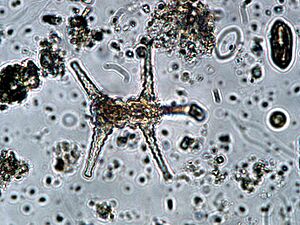Charophyceae facts for kids
The Charophyceae are a special group of green algae. Scientists believe they are the closest living relatives to all land plants. This makes them very important for understanding how plants first moved from water to land.
Contents
What Are Charophyceae?
Charophyceae are a class of green algae. They belong to a larger group called Charophyta. These algae are mostly found in fresh water. They can look very different from each other. Some are tiny and single-celled. Others form long, branching chains.
Why Are Charophyceae Important?
Scientists study Charophyceae to learn about plant evolution. Many features that land plants have, like how they reproduce, first appeared in these algae. For example, some Charophyceae have complex ways of sexual reproduction. These ways are similar to how early plants reproduced.
Charophyceae share many traits with land plants. One key trait is how their chloroplasts are structured. Chloroplasts are the parts of a plant cell that make food using sunlight. Studies of their DNA show that plant chloroplasts likely evolved from those found in Charophyceae. This means Charophyceae are like a bridge between simple algae and complex land plants.
Types of Charophyceae
The Charophyceae group includes several different orders. Each order has its own unique features. Here are some of the main groups:
- Mesostigmatales
- Klebsormidiales
- Zygnematales
- Desmidiales
- Charales
- Coleochaetales
These groups show a range of forms and ways of life. They help scientists piece together the story of plant evolution.
See also
 In Spanish: Carofíceas para niños
In Spanish: Carofíceas para niños



